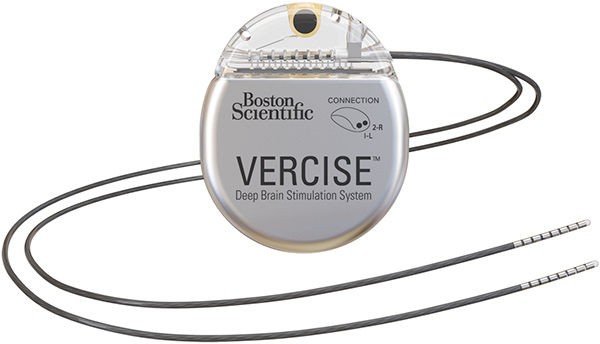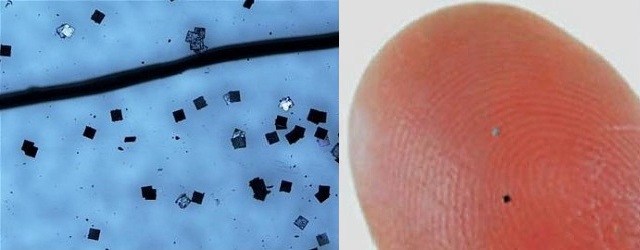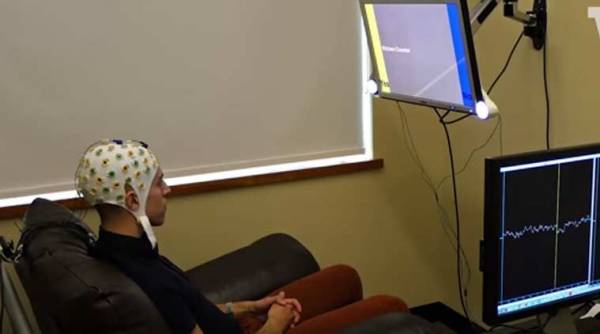My Body Gadget (Part # 2)

"... as a result of the implantation, not only the cerebral cortex was affected, but also the wood itself, so to speak"
(from inspection report)
Gadgets, they are like viruses today. They are invisible, they are omnipresent, they easily enter the body and will soon be able to do there whatever they want. Rather, everything that will be incorporated in their software or that the one who has the control panel in their hands wants ...
Let's continue today to talk about what the development of the Internet of Things (IoT) offers us the market of modern gadgets. For those who missed - the first part can be found here .
Embedded in the body
Perhaps the most widely known and widespread use of implanted wearable electronics is pacemakers . Since the development of the first sample in 1961, tens of millions of people have used this type of wearable electronics. Modern pacemakers have more advanced properties and advanced features.

Artificial e-skin (e-skin) can partially implement this idea. Scientists from the University of Tokyo (University of Tokyo's School of Engineering, Tokyo, Japan) are developing flexible electronic circuits that can be installed directly on human skin. They are easily deformed and stretched, turning the surface into a touch screen, which is useful not only in everyday life, but also in cases of violation of local innervation (for example, burns). The simplest version of this technology is a tattoo , on each variety of which various groups of specialists have been working for a long time.
Researchers at the University of Illinois have developed an implantable mesh of computer fibers that are thinner than a human hair and can monitor the body's internal processes from the surface of the skin. Dangerous Things has developed an NFC chip that is implanted into a finger using a very simple tattoo-like process, and allows you to unlock devices or enter code simply by pointing the right gadget with your finger. In the world for a long time there are fans who have placed such chips in themselves.

Specialists at Northeastern University in the United States developed a “ tattoo ” with embedded nanosensors that is designed to control the level of oxygen in the blood of patients with anemia . The same system can be used, for example, by cyclists when monitoring sodium levels to prevent dehydration. The method consists of an injection under the skin of a solution containing specially selected nanoparticles that fluoresce when interacting with sodium or glucose molecules. Using a smartphone you can control changes in the level of fluorescence.

A number of companies are engaged in the development of sensors in the form of a temporary tattoo - a thin film glued to the skin. In particular, Electrozyme has developed a sensor for metabolic substances secreted along with sweat, which allows athletes to evaluate their electrolyte balance, level of hydration, muscle tension and physical performance. University of California scientists use similar technology to monitor diabetes.

Instead of a tattoo, you can create a new skin. Standard electronic skin consists of a matrix, which includes various electronic components - flexible transistors, organic light-emitting diodes and photovoltaic cells. Often, such devices are built of very thin layers of material sprayed and re-condensed on the basis of a large (up to several tens of square centimeters) basis for e-skin. Over time, scientists hope to turn the skin itself into a sensitive screen using tactile centers and sensors instead of a display.
Spare parts
Sometimes it happens that something in the patient's body has to be replaced with a completely artificial product. And not without reason, prosthetics is today one of the most popular and progressive directions in the development of wearable electronics. Of course, science has not yet reached the artificial hand of Luke Skywalker, but the success of electronics is already evident.

In particular, modern bionic prostheses have expanded the capabilities of people with disabilities. Functionally, they maximally make up, for example, the movements of a human leg, ensure safety in all phases of a step, naturalness and harmony of movements, give the patient a feeling of confidence on any surface. At the heart of almost any modern prosthesis is a microprocessor, which is associated with a large number of sensors located throughout the product. Sensors collect information about the inclination of the surface and the relief of the road, the load on the prosthesis. Thanks to them, the central microprocessor receives and processes all the necessary information, in accordance with which the knee module operates. The intelligent control of the prosthesis allows the user to move at their own comfortable pace.

Already developed a device that allows blind people to see. " Electronic eyes " are glasses with built-in CMOS cameras that capture the image, process it and convert it into a matrix of control signals implanted into the human brain by electrodes. With the help of electrical stimulation signals applied to the electrodes, a rough relief is displayed, highlighting the contours of the objects in the middle ground for orientation. This device does not allow seeing as sighted people see, but the general layout of the objects surrounding it becomes available to the person.

The German company Implandata Ophthalmic Products has developed an implant that allows for constant monitoring of eye pressure to control the development of glaucoma.
But, of course, the most important stage of any prosthesis is the ability to control the “foreign body” with the help of its own nervous system.
United inside
Currently, the task of combining all these devices with the human body is being solved in such a way as to fully interact with the nervous system, since organic materials based on carbon are practically not rejected by the body. True, carbon particles diffuse well through the cell membranes, which may cause the body’s immune response, which is not very well understood by specialists, and, according to unconfirmed theories, even cause tumors. In the coming years, we will probably see how prototypes of electronic devices based on artificial leather enter everyday life as wearable sensors, screens, and even batteries that accumulate the energy received directly from the human body. Then the time will come for the built-in smartphones, and people will be able to become cyborg (if they need it, of course, or, for example, if it is spelled out in the state constitution).
Even further, scientists are working to create technologies that transform our entire body into a user interface with which people can control a wide variety of devices.

In the US agency DARPA (Defense Advanced Research Projects Agency) implants are being developed in the brain that can both record signals coming from nerve nodes along an array of electrodes and stimulate other nerve nodes in real time in order to effectively reconnect the damaged sections of the brain, which allows restore memory. An external device is placed near the ear, which can exchange data with the implant and control its operation.

Tactile interfaces are only the first step in turning our body into the center of control of an army of devices that facilitate and improve human life. For example, in Japan and Italy, devices are being created that allow people with disabilities to open the door or answer a phone call literally with the power of thought . In addition, microchips are being developed that will not only restore lost neural connections, but also create new ones.
Already today, there are patients who use implanted devices that work in conjunction with a mobile application in order to open a combination lock or control the course of the disease, or even treat it. In particular, the bionic pancreas , which is being tested at Boston University in the USA, has a micro sensor on a needle implanted in the body, which transmits data on blood sugar levels to a smartphone.

Stimwave Technologies has developed a miniature neurostimulator device for relieving back and leg pain. It is a wireless implant with a built-in chip and electrodes and is introduced into the body with an ordinary needle.
The Gates Foundation is supporting a project at the Massachusetts University of Technology to create an implantable female contraceptive that can be controlled outside. This is a tiny, body-embedded chip that generates small amounts of the contraceptive hormone inside the female body and can last up to 16 years without interruption. Implantation is no more painful than tattooing. In addition, according to the developers, "the ability to turn on or turn off the device is a very convenient tool for those planning their family composition." The main thing is not to lose the remote control ...
Boston Scientific has developed the implantable brain neurostimulator Vercise, which is designed to treat people with tremor (chronic tremor) . The implantable device contains a battery that can work for 25 years without replacement, and the device itself can be very precisely tuned according to the anatomy and needs of the patient.

In general, neurostimulation activates brain areas responsible for memory, reaction, concentration, mathematical and linguistic abilities, and here you can expect a lot more news.

The task of the European project SmartHand is to create a replaceable arm that will be as close in function to the lost one as possible. SmartHand is a complex prosthesis with four motors and 40 sensors that connects directly to the patient's nervous system. SmartHand creates the sensation of a ghostly hand, known to many who have lost a limb. The first patient was already able to pick up objects and feel the tips of the fingers of the prosthesis.
Smart Dust or “smart dust” is perhaps the latest innovation in implantology. Imagine a matrix of real computers with antennas, each of which is much smaller than a grain of sand that can self-organize inside the body into any desired network in order to ensure the implementation of various complex internal processes. Swarms of these micro devices can attack the early manifestations of cancer or relieve pain in a wound. Perhaps they will be able to store important information that is difficult to decipher or steal. Using “smart dust”, doctors will be able to perform various actions without the need to violate the integrity of the body - deliver the right drugs to the right places, conduct internal operations, examine the internal organs and much more.

Feeding part
Whatever electronics is used, it needs a battery. Currently, this is done using miniature chemical batteries, metal hydride and polymer batteries, fuel cells, thermogenerators, piezo transducers, and kinetic energy into electrical energy converters. And, for example, one of the most important problems of implantation technologies is the delivery of power to a device that is in the human body, and it cannot be removed or plugged into an electrical outlet.
Researchers at Draper's Lab at Cambridge University have developed a biodegradable battery that can generate energy inside the body, transmit it wirelessly if necessary, and then dissolve and disappear.

Connected to the brain
There are enough skeptics in the academic world, but there are enough of those who enthusiastically accept new human capabilities.
Surely the electronics in our body will immediately be used for entertainment. The possibilities are endless - from creating realistic images right in the human eye to realistic simulations of gaming reality. The main thing again - do not lose control of all these wonderful devices.
In the near future, predictions about weapons that work only in the hands of the owner will already be realized. A password will be added to the fingerprint authorization, which is embedded in your personal identification chip.
Connecting the human brain directly to a computer is a dream (or nightmare) of lovers of fiction and wonderful inventions. And this dream seems to be close to realization. Researchers at BrainGate at Brown University in the United States are engaged in precisely this task. Using an aspirin pill-sized electrode set implanted into the brain, scientists were able to show that neuron signals can be real-time decoded by a computer and used to control various devices. A team of researchers from the University of the Witwatersrand in Johannesburg has already connected the human brain directly to the Internet in real time . The project is called Brainternet, which resonates well with the above. The data collected during the experiment should help developers create new generation interfaces.

Intel predicted that the transition to practical use of the human-computer interface will begin before 2020 . Imagine that you have gained the ability to use the Internet using your thinking abilities, which may seem like a phenomenal opportunity. It remains only to learn how to get rid of viruses with hackers and confusion in thoughts. Perhaps someone will even help you figure it out. And it is possible that this “someone” may turn out to be a Big Brother , to whom controlled cyborgs will be very useful. Thus, progressive humanity is on the verge of changes that can make the world much more convenient, more comfortable, and, as some think, politically more intelligent.
On the other hand, having learned how to use the brain as a tool for controlling external, wearable and embedded electronics, humanity takes another step toward what has been created by nature long ago. For example, is it not with the help of the brain that we control our body? And, maybe, they did not fully understand that we still know how?
Publication author:
Alexander GOLYSHKO, Systems Analyst, Technoserv Group of Companies
Based on: kit-e.ru, zhenskiyblog.ru, 3dnews.ru, ferra.ru, 374.ru, kaspersky.com, hi-news.ru, popmech.ru, ixbt.com, orto-kosmos.ru.
')
Source: https://habr.com/ru/post/344400/
All Articles